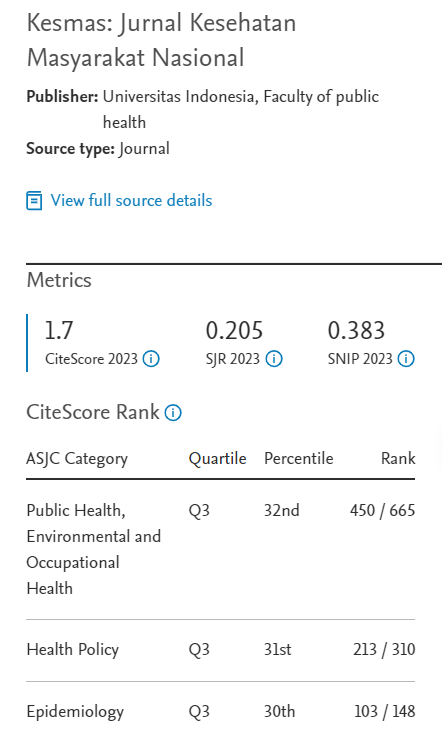Abstract
Identifying specific tuberculosis (TB) vulnerabilities in populations based on their geographical, demographic, and epidemiological characteristics is anessential yet challenging requirement to help reduce and eliminate TB. Assessment tools that can accurately quantify the risks associated with key factorscould be used to measure TB vulnerability efficiently and indicate the most appropriate range of interventions. This study aimed to develop TB vulnerability assessment tools based on a TB vulnerability assessment conceptual framework developed with Leximancer. Three steps to produce the tools were facetanalysis, interpreting the facet to create a list of questions, and expert judgment to confirm the suitability of the questionnaire. The “everything is data” principlewas used to identify the data sources and build the tools. The data came from multiple primary data sources, with a questionnaire survey and observational form, and secondary data from various governmental statistical departments in Indonesia to collect data related to demography, health indicators, climate,temperature, and air quality. These tools will be optimized at scale next year to evaluate their utility for prioritizing and prescribing health system responses to TB in different communities in Central Java Province.
References
1. World Health Organization. The End TB Strategy. Geneva: World Health Organization; 2015.
2. World Health Organization. Global Tuberculosis Report 2022. Geneva: World Health Organization; 2022.
3. Kementerian Kesehatan Republik Indonesia. Strategi Nasional Penanggulangan Tuberkulosis di Indonesia 2020–2024. Jakarta: Kementerian Kesehatan Republik Indonesia; 2020.
4. Rahayu SR, Katsuyama H, Demura M, et al. Factors associated with tuberculosis cases in Semarang District, Indonesia: Case-control study performed in the area where case detection rate was extremely low. Environ Health Prev Med. 2015; 20 (4): 253–261. DOI: 10.1007/s12199-015-0443-9
5. Zhang Y, Liu M, Wu SS, et al. Spatial distribution of tuberculosis and its association with meteorological factors in mainland China. BMC Infect Dis. 2019; 19 (1): 379. DOI: 10.1186/s12879-019-4008-1
6. Beiranvand R, Karimi A, Delpisheh A, et al. Correlation Assessment of Climate and Geographic Distribution of Tuberculosis Using Geographical Information System (GIS). Iran J Public Health. 2016; 45 (1): 86–93.
7. The Republic of Indonesia Joint External Monitoring Mission for Tuberculosis. Geneva: World Health Organization; 2020.
8. Balakrishnan SK, Suseela RP, Mrithyunjayan S, et al. Individuals’ Vulnerability Based Active Surveillance for TB: Experiences from India. Trop Med Infect Dis. 2022; 7 (12): 441. DOI: 10.3390/tropicalmed7120441
9. Vanleeuw L, Zembe-Mkabile W, Atkins S. Falling through the cracks: Increased vulnerability and limited social assistance for TB patients and their households during COVID-19 in Cape Town, South Africa. PLoS Glob Public Health. 2022; 2 (7): e0000708. DOI: 10.1371/journal.pgph.0000708
10. Trivianita N, Marsisno W, Wilantika N. Social Vulnerability Index to Tuberculosis of Provinces in Indonesia. Adv Soc Sci Educ Hum Res. Atlantis Press. 2019; 216: 170–180.
11. Handayani S, Hinchcliff R, Hasibuan ZA. Development of Tuberculosis Vulnerability Assessment Conceptual Framework Using Automatic Content Analysis. Healthcare Transformation with Informatics and Artificial Intelligence. Amsterdam: IOS Press; 2023. p. 220–223. DOI: 10.3233/SHTI230467
12. Ward V, West R, Smith S, et al. The role of informal networks in creating knowledge among healthcare managers: A prospective case study. Health Serv Deliv Res. 2014; 2 (12). DOI: 10.3310/hsdr02120
13. Engstrom T, Strong J, Sullivan C, et al. A Comparison of Leximancer Semi-automated Content Analysis to Manual Content Analysis: A Healthcare Exemplar Using Emotive Transcripts of COVID-19 Hospital Staff Interactive Webcasts. Int J Qual Methods 2022; 21: 16094069221118993. DOI: 10.1177/16094069221118993
14. Rahmah A, Santoso HB, Hasibuan ZA. Critical Review of TechnologyEnhanced Learning using Automatic Content Analysis Case Study of TEL Maturity Assessment Formulation. Int J Adv Comput Sci Appl. 2022; 13 (1). DOI: 10.14569/IJACSA.2022.0130148
15. Raghupathi W, Raghupathi V. Big data analytics in healthcare: Promise and potential. Health Inf Sci Syst. 2014; 2: 3. DOI: 10.1186/2047-2501-2-3
16. Yunita A, Santoso HB, Hasibuan ZA. ‘Everything is data’: Towards one big data ecosystem using multiple sources of data on higher education in Indonesia. J Big Data. 2022; 9: 91. DOI: 10.1186/s40537-022-00639-7
17. Zhou X, Lee EWJ, Wang X, et al. Infectious diseases prevention and control using an integrated health big data system in China. BMC Infect Dis. 2022; 22: 344. DOI: 10.1186/s12879-022-07316-3
18. Bhardwaj N, Wodajo B, Spano A, et al. The Impact of Big Data on Chronic Disease Management. Health Care Manag. 2018; 37 (1): 90– 98. DOI: 10.1097/HCM.0000000000000194
19. Bhargava S, Jain M, Jain M. In tuberculosis, “One size does not fit all.” Lung India. 2019; 36 (1): 1–2. DOI: 10.4103/lungindia.lungindia_489_18
Recommended Citation
Isworo S , Handayani S , Hinchcliff R ,
et al.
Development of an Evidence-Based Tool to Assess the Relative Vulnerability of Different Communities to Tuberculosis.
Kesmas.
2023;
18(4):
252-257
DOI: 10.21109/kesmas.v18i4.7357
Available at:
https://scholarhub.ui.ac.id/kesmas/vol18/iss4/6







